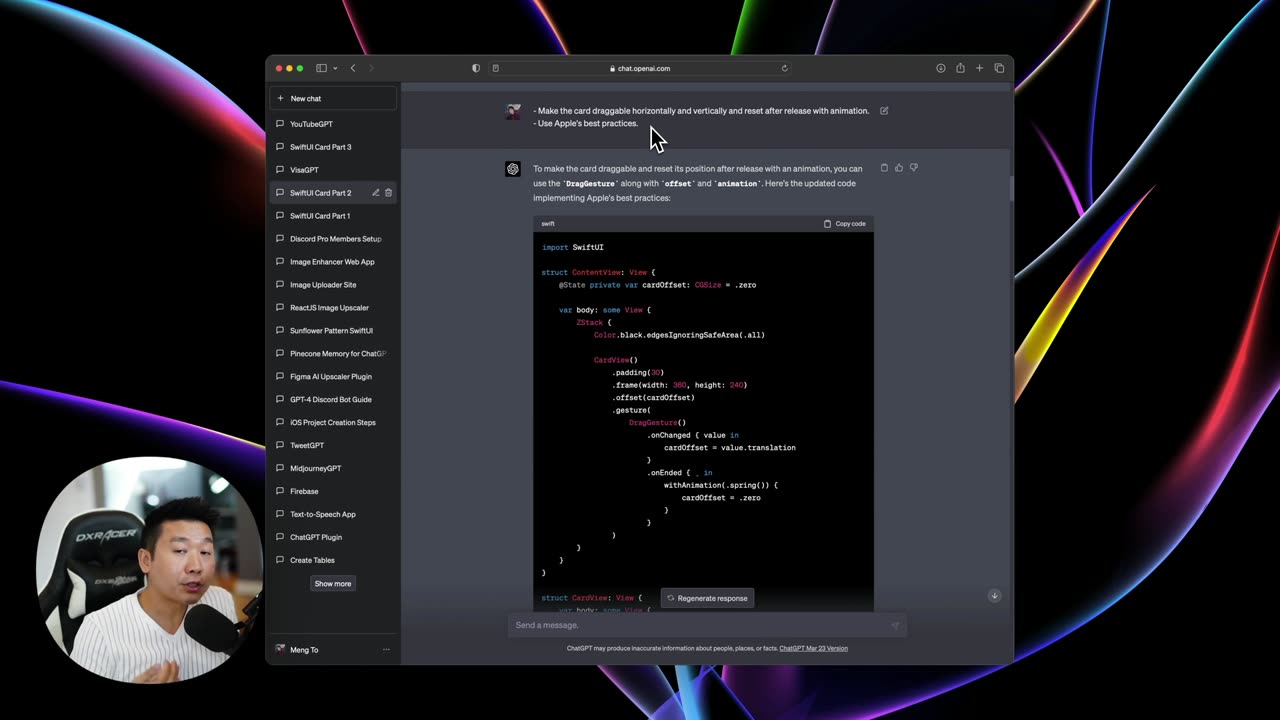Premium Only Content

08. SwiftUI Card Drag Gesture
In SwiftUI, implementing a card drag gesture involves adding interactive functionality to a card UI component, allowing users to drag the card across the screen. This feature enhances the user interface by introducing a tactile and intuitive way for users to interact with the elements of your app.
To achieve this, SwiftUI utilizes its powerful gesture modifiers. Here's a brief overview of how a drag gesture can be implemented in a SwiftUI card:
Gesture Recognition: You start by attaching a .gesture() modifier to your card view. Within this modifier, you define a DragGesture() which SwiftUI uses to recognize and respond to drag actions.
State Tracking: SwiftUI tracks the state of the gesture, such as its position and whether it's currently active. You typically use state variables to store this information, updating them as the user drags the card.
Movement and Animation: As the user drags the card, SwiftUI updates the card's position on the screen in real-time. This is often accompanied by animations to make the movement smooth and visually appealing. You can control the card's position and how it reacts to the drag using SwiftUI's animation and transition modifiers.
End of Gesture Handling: When the user releases the card, you can define actions or animations to finalize the gesture. For example, the card might snap back to its original position or move to a new location based on where the user released it.
Feedback and Accessibility: Providing visual or haptic feedback during the drag can enhance the user experience. Additionally, ensuring that the drag gesture is accessible and easy to use is crucial for inclusivity.
Incorporating a drag gesture into a SwiftUI card not only makes the interface more interactive but also opens up new possibilities for user interaction, such as swiping cards to dismiss them or dragging them to reorder in a list. It's a great way to make your app more engaging and intuitive.
-
 1:03:22
1:03:22
IsaacButterfield
13 hours ago $4.66 earnedKaty Perry in Space?! Trans Women Law Controversy & Lizzo's Weight Loss Shocks Fans!
54.5K16 -
 6:15:39
6:15:39
Sm0k3m
10 hours agogaming night
51.6K1 -
 3:48:35
3:48:35
I_Came_With_Fire_Podcast
18 hours agoHOUTHIS & CHINA | MURDERER MERCH STORE | TRUMP SICK OF WAITING
55K10 -
 1:09:15
1:09:15
Keepslidin
8 hours ago $1.07 earnedIRL GAMBLING & GIVING PEOPLE MONEY WHEN THEY WIN
30.7K5 -
 6:10:30
6:10:30
Eternal_Spartan
19 hours agoLive at 9pm Central | Halo 3 & Halo Firefight! Come Hang out with a USMC Vet and join the best chat!
31.1K1 -
 4:06:20
4:06:20
VapinGamers
10 hours ago $1.81 earnedFortnite Friday - Game Night with the Family - !brian !rumbot
34.9K6 -
 59:22
59:22
Motherland Casino
8 hours ago $1.82 earnedScar x Ayanna
19K11 -
 53:30
53:30
Sarah Westall
12 hours agoLingering IRA Scandal, Central Banker’s Criminal Dilemma and the Silver Squeeze w/ Andy Schectman
54.4K8 -
 1:10:36
1:10:36
Edge of Wonder
15 hours agoWhite House: ‘We Can Manipulate Time and Space’
55.3K30 -
 9:00:11
9:00:11
ZWOGs
17 hours ago🔴LIVE IN 1440p! - Hunt: Showdown, Schedule 1, TARKOV, GTAV RP!! | Dwindle Digby | - Come Hang Out!
17.5K2